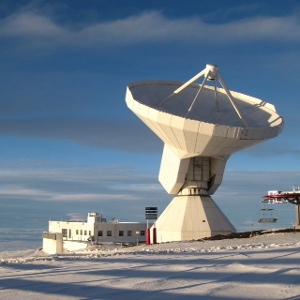|
|  |
Galaxies in the nearby Universe come in a wide variety of shapes,
colours and sizes, yet this diverse population is found to obey many
complex relations between their different properties. A global
picture emerges, where galaxies mostly fall in one of two categories:
either they are gas-rich, blue, spiral-like and actively star-forming,
or else they are red, gas-poor and featureless. If we want to
understand how galaxies form and evolve such as to produce this
picture, it is essential to pinpoint when, where and how stars are
formed in any galaxy. While detailed observations of the stellar
light of galaxies can already teach us a great deal, a major hurdle in
our understanding is our comparatively poor knowledge of the gas
contents of these galaxies. Since cold gas is the fuel for star
formation, we need a better picture of how galaxies are supplied in
gas, how they process this gas into stars, and how some of the gas is
then returned to the outside environment. Only then can we hope to
really understand how galaxies evolve.
To answer these questions, scientists at the Max Planck Institute for
Astrophysics are part of an international team currently using some of
the world's largest radio telescopes to map the gas contents of
massive galaxies in the nearby Universe. Complementary information
comes from the extensive multi-wavelength data set that is being
assembled by the team, including data from the Sloan Digital Sky
Survey (SDSS), the UV satellite GALEX, and the Arecibo
radio-telescope.
The IRAM 30-metre telescope, atop Pico Veleta in southern Spain, is
providing key information about how gas is transformed into stars.
The telescope, which is funded and operated by the French CNRS, the
German Max Planck Society and the Spanish IGN, can observe at
millimetre wavelengths and trace the presence of molecular gas in
galaxies - allowing the scientists a glimpse at the last step along
the cycle of gas: Once gas is accreted onto galaxies, it cools in
regions where it is compressed, leading to the formation of molecules
and then stars. The COLD GASS survey team, led by Amelie Saintonge
from MPE and Guinevere Kauffmann from MPA, has used the IRAM 30-m
telescope to perform a census of this molecular gas in a sample of 350
galaxies representative of the population of massive galaxies in the
nearby Universe.
The survey so far has been used to trace the abundance of molecular
gas in galaxies as a function of their mass, colour and
morphology. This showed impressively the existence of sharp divides in
the galaxy population based on their gas contents. With the IRAM
observations, the scientists could identify a population of galaxies
with no more than trace amounts of molecular gas. These galaxies are
the most passive at the present epoch, with very little to no on-going
star formation.
A surprising result emerges when the IRAM data are combined with the
extensive multi-wavelength data set: While the IRAM observations find
this population of "red and dead" galaxies, with no significant trace
of either molecular gas or star formation, the Arecibo radio telescope
shows that these galaxies can contain a significant amount of atomic
gas, which under normal circumstances would cool and ultimately form
stars.
Why can these galaxies be rich in atomic gas and yet not be able to
form stars? This observation alone tells us about the existence of a
bottleneck in the star formation process in massive galaxies: it is
not enough for a galaxy to have a large reservoir of atomic gas; the
conditions have to be just right for this gas to reach the low
temperatures and high densities required for star formation. The
results of large numerical simulations, also conducted by the MPA team
and their collaborators, are now being tested against these
observations. The combination of these detailed simulations and the
large body of data provided by the COLD GASS survey will likely mark a
step forward in our understanding of how galaxies evolve through the
cycling of gas and the formation of stars.
Amelie Saintonge
Related Links
 COLD GASS COLD GASS
 GASS GASS
 IRAM IRAM
Publications
Amelie Saintonge, Guinevere Kauffmann, Carsten Kramer et al.,
"COLD GASS, an IRAM legacy survey of molecular gas in massive galaxies - I.
Relations between H2, HI, stellar content and structural properties",
2011, MNRAS, 415, 32
 http://onlinelibrary.wiley.com/doi/10.1111/j.1365-2966.2011.18677.x/full
http://onlinelibrary.wiley.com/doi/10.1111/j.1365-2966.2011.18677.x/full
Amelie Saintonge, Guinevere Kauffmann, Jing Wang et al.,
"COLD GASS, an IRAM legacy survey of molecular gas in massive galaxies - II. The
non-universality of the molecular gas depletion time-scale",
2011, MNRAS, 415, 61
 http://onlinelibrary.wiley.com/doi/10.1111/j.1365-2966.2011.18823.x/full
http://onlinelibrary.wiley.com/doi/10.1111/j.1365-2966.2011.18823.x/full
Barbara Catinella, David Schiminovich, Guinevere Kauffmann et al.,
"The GALEX Arecibo SDSS Survey - I. Gas fraction scaling relations of
massive galaxies and first data release",
2010, MNRAS, 403, 683
 http://onlinelibrary.wiley.com/doi/10.1111/j.1365-2966.2009.16180.x/full
http://onlinelibrary.wiley.com/doi/10.1111/j.1365-2966.2009.16180.x/full
Silvia Fabello, Barbara Catinella, Riccardo Giovanelli et al.,
"ALFALFA HI data stacking - I. Does the bulge quench ongoing star formation in early-type galaxies?",
2011, MNRAS, 411, 993
 http://onlinelibrary.wiley.com/doi/10.1111/j.1365-2966.2010.17742.x/full
http://onlinelibrary.wiley.com/doi/10.1111/j.1365-2966.2010.17742.x/full
|


